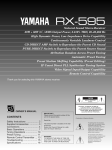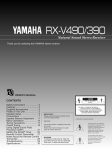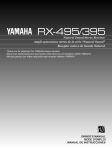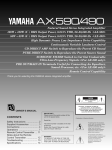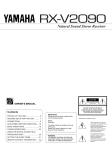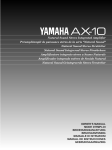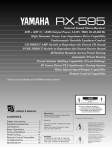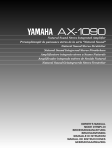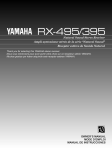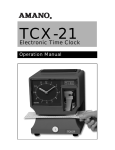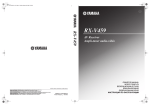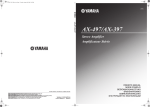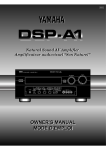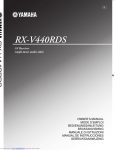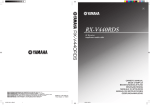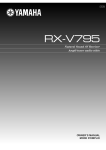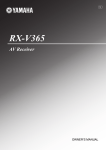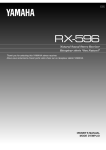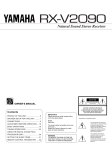Download Yamaha RX-596 Receiver
Transcript
UCA RX-596 Natural Sound Stereo Receiver Récepteur stéréo “Son Naturel” Thank you for selecting this YAMAHA stereo receiver. Nous vous remercions d’avoir porté votre choix sur ce récepteur stéréo YAMAHA. OWNER’S MANUAL MODE D’EMPLOI • Explanation of Graphical Symbols CAUTION RISK OF ELECTRIC SHOCK DO NOT OPEN CAUTION: TO REDUCE THE RISK OF ELECTRIC SHOCK, DO NOT REMOVE COVER (OR BACK). NO USER-SERVICEABLE PARTS INSIDE. REFER SERVICING TO QUALIFIED SERVICE PERSONNEL. IMPORTANT Please record the serial number of this unit in the space below. Model: Serial No.: The serial number is located on the rear of the unit. Retain this Owner’s Manual in a safe place for future reference. The lightning flash with arrowhead symbol, within an equilateral triangle, is intended to alert you to the presence of uninsulated “dangerous voltage” within the product’s enclosure that may be of sufficient magnitude to constitute a risk of electric shock to persons. The exclamation point within an equilateral triangle is intended to alert you to the presence of important operating and maintenance (servicing) instructions in the literature accompanying the appliance. WARNING TO REDUCE THE RISK OF FIRE OR ELECTRIC SHOCK, DO NOT EXPOSE THIS UNIT TO RAIN OR MOISTURE. SAFETY INSTRUCTIONS 1 2 Read Instructions – All the safety and operating instructions should be read before the unit is operated. Retain Instructions – The safety and operating instructions should be retained for future reference. 3 Heed Warnings – All warnings on the unit and in the operating instructions should be adhered to. 4 Follow Instructions – All operating and other instructions should be followed. 5 6 Water and Moisture – The unit should not be used near water – for example, near a bathtub, washbowl, kitchen sink, laundry tub, in a wet basement, or near a swimming pool, etc. Carts and Stands – The unit should be used only with a cart or stand that is recommended by the manufacturer. 6A A unit and cart combination should be moved with care. Quick stops, excessive force, and uneven surfaces may cause the unit and cart combination to overturn. 7 Wall or Ceiling Mounting – The unit should be mounted to a wall or ceiling only as recommended by the manufacturer. 8 Ventilation – The unit should be situated so that its location or position does not interfere with its proper ventilation. For example, the unit should not be situated on a bed, sofa, rug, or similar surface, that may block the ventilation openings; or placed in a built-in installation, such as a bookcase or cabinet that may impede the flow of air through the ventilation openings. 9 Heat – The unit should be situated away from heat sources such as radiators, stoves, or other appliances that produce heat. 10 Power Sources – The unit should be connected to a power supply only of the type described in the operating instructions or as marked on the unit. 11 Power-Cord Protection – Power-supply cords should be routed so that they are not likely to be walked on or pinched by items placed upon or against them, paying particular attention to cords at plugs, convenience receptacles, and the point where they exit from the unit. 12 Cleaning – The unit should be cleaned only as recommended by the manufacturer. 13 Nonuse Periods – The power cord of the unit should be unplugged from the outlet when left unused for a long period of time. 14 Object and Liquid Entry – Care should be taken so that objects do not fall into and liquids are not spilled into the inside of the unit. 15 Damage Requiring Service – The unit should be serviced by qualified service personnel when: A. The power-supply cord or the plug has been damaged; or B. Objects have fallen, or liquid has been spilled into the unit; or C. The unit has been exposed to rain; or D. The unit does not appear to operate normally or exhibits a marked change in performance; or E. The unit has been dropped, or the cabinet damaged. 16 Servicing – The user should not attempt to service the unit beyond those means described in the operating instructions. All other servicing should be referred to qualified service personnel. 17 Power Lines – An outdoor antenna should be located away from power lines. 18 Grounding or Polarization – Precautions should be taken so that the grounding or polarization is not defeated. Outdoor Antenna Grounding – If an outside antenna is connected to this unit, be sure the antenna system is grounded so as to provide some protection against voltage surges and built-up static charges. Article 810 of the National Electrical Code, ANSI/NFPA 70, provides information with regard to proper grounding of the mast and supporting structure, grounding of the lead-in wire to an antenna discharge unit, size of grounding conductors, location of antenna discharge unit, connection to grounding electrodes, and requirements for the grounding electrode. Note to CATV system installer: This reminder is provided to call the CATV system installer’s attention to Article 820-40 of the NEC that provides guidelines for proper grounding and, in particular, specifies that the cable ground shall be connected to the grounding system of the building, as close to the point of cable entry as practical. English 19 For US customers only: EXAMPLE OF ANTENNA GROUNDING MAST ANTENNA LEAD IN WIRE GROUND CLAMP ANTENNA DISCHARGE UNIT (NEC SECTION 810–20) ELECTRIC SERVICE EQUIPMENT GROUNDING CONDUCTORS (NEC SECTION 810–21) GROUND CLAMPS POWER SERVICE GROUNDING ELECTRODE SYSTEM (NEC ART 250. PART H) NEC – NATIONAL ELECTRICAL CODE SPECIAL NOTES FOR FCC COMPOSITE DEVICE (for US customers only) This device is a composite system. The digital device component may not cause harmful interference. FCC INFORMATION (for US customers only) 1. IMPORTANT NOTICE : DO NOT MODIFY THIS UNIT! This product, when installed as indicated in the instructions contained in this manual, meets FCC requirements. Modifications not expressly approved by Yamaha may void your authority, granted by the FCC, to use the product. 2. IMPORTANT : When connecting this product to accessories and/or another product use only high quality shielded cables. Cable/s supplied with this product MUST be used. Follow all installation instructions. Failure to follow instructions could void your FCC authorization to use this product in the USA. 3. NOTE : This product has been tested and found to comply with the requirements listed in FCC Regulations, Part 15 for Class “B” digital devices. Compliance with these requirements provides a reasonable level of assurance that your use of this product in a residential environment will not result in harmful interference with other electronic devices. This equipment generates/uses radio frequencies and, if not installed and used according to the instructions found in the users manual, may cause interference harmful to the operation of other electronic devices. Compliance with FCC regulations does not guarantee that interference will not occur in all installations. If this product is found to be the source of interference, which can be determined by turning the unit “OFF” and “ON”, please try to eliminate the problem by using one of the following measures: Relocate either this product or the device that is being affected by the interference. Utilize power outlets that are on different branch (circuit breaker or fuse) circuits or install AC line filter/s. In the case of radio or TV interference, relocate/reorient the antenna. If the antenna lead-in is 300 ohm ribbon lead, change the lead-in to coaxial type cable. If these corrective measures do not produce satisfactory results, please contact the local retailer authorized to distribute this type of product. If you can not locate the appropriate retailer, please contact Yamaha Electronics Corp., U.S.A. 6660 Orangethorpe Ave, Buena Park, CA 90620. The above statements apply ONLY to those products distributed by Yamaha Corporation of America or its subsidiaries. We Want You Listening For A Lifetime (for US customers only) YAMAHA and the Electronic Industries Association’s Consumer Electronics Group want you to get the most out of your equipment by playing it at a safe level. One that lets the sound come through loud and clear without annoying blaring or distortion – and, most importantly, without affecting your sensitive hearing. Since hearing damage from loud sounds is often undetectable until it is too late, YAMAHA and the Electronic Industries Association’s Consumer Electronics Group recommend you to avoid prolonged exposure from excessive volume levels. 1 FEATURES ● 80W + 80W (8Ω) RMS Output Power, 0.025% THD, 20–20,000 Hz ● 40-Station Random Access Preset Tuning ● 90W + 90W (6Ω) RMS Output Power, 0.05% THD, 20–20,000 Hz ● Preset Station Shifting Capability (Preset Editing) ● High Dynamic Power, Low Impedance Drive Capability ● IF Count Direct PLL Synthesizer Tuning System ● Continuously Variable LOUDNESS Control ● Video Signal Input/Output Capability ● CD DIRECT AMP Switch to Reproduce the Purest CD Sound ● SLEEP Timer ● Automatic Preset Tuning ● PURE DIRECT Switch to Reproduce the Purest Source Sound ● Remote Control Capability CONTENTS SAFETY INSTRUCTIONS.......Inside the Front Cover CONTROLS AND THEIR FUNCTIONS ...........9 FEATURES ......................................................2 BASIC OPERATIONS ....................................13 SUPPLIED ACCESSORIES ............................3 TUNING OPERATIONS .................................16 CAUTION .........................................................4 PRESET TUNING ..........................................17 NOTES ABOUT THE REMOTE CONTROL TRANSMITTER................................................5 TROUBLESHOOTING ...................................20 CONNECTIONS...............................................6 2 SPECIFICATIONS..........................................21 English SUPPLIED ACCESSORIES After unpacking, check that the following parts are included. Indoor FM Antenna Remote Control Transmitter YAMAHA HIFI SYSTEM REMOTE CONTROL TRANSMITTER AM Loop Antenna LD/TV DIR A DIR B REC/PAUSE – + PLAY A/B PRESET A/B/C/D/E DISC PLAY VCD/TAPE 2 TAPE 1 TUNER CD PHONO POWER ON OFF VOLUME SLEEP Antenna adapter (U.S.A. and Canada models only) Batteries (size AA, R6, UM-3) 3 CAUTION : READ THIS BEFORE OPERATING YOUR UNIT. 1. To assure the finest performance, please read this manual carefully. Keep it in a safe place for future reference. 2. Install this unit in a cool, dry, clean place – away from windows, heat sources, sources of excessive vibration, dust, moisture and cold. Avoid sources of humming (transformers, motors). To prevent fire or electrical shock, do not expose the unit to rain or water. 3. Never open the cabinet. If something drops into the set, contact your dealer. 4. Do not use force on switches, controls or connection wires. When moving the unit, first disconnect the power plug and the wires connected to other equipment. Never pull the wires themselves. 5. The openings on the cabinet assure proper ventilation of the unit. If these openings are obstructed, the temperature inside the cabinet will rise rapidly. Therefore, avoid placing objects against these openings, and install the unit in wellventilated condition. Be sure to allow a space of at least 10 cm behind, 10 cm on the both sides and 20 cm above the top panel of the unit. Otherwise it may not only damage the unit, but also cause fire. 6. Always set the VOLUME control to “– ∞” before starting the audio source play. Increase the volume gradually to an appropriate level after playback has been started. 7. Do not attempt to clean the unit with chemical solvents; this might damage the finish. Use a clean, dry cloth. 8. Be sure to read the “TROUBLESHOOTING” section regarding common operating errors before concluding that the unit is faulty. 9. When not planning to use this unit for long periods of time (ie., vacation, etc.), disconnect the AC power plug from the wall outlet. 10. To prevent lightning damage, disconnect the AC power plug and antenna cable when there is an electrical storm. 11. Grounding or polarization – Precautions should be taken so that the grounding or polarization of an appliance is not defeated. 12. Do not connect audio equipment to the AC outlet on the rear panel if the equipment requires more power than the outlet is rated to provide. 4 This unit is not disconnected from the AC power source as long as it is connected to the wall outlet, even if this unit itself is turned off. This state is called the standby mode. In this state, this unit is designed to consume a very small quantity of power. IMPORTANT Please record the serial number of this unit in the space below. Model: Serial No.: The serial number is located on the rear of the unit. Retain this Owner’s Manual in a safe place for future reference. WARNING TO REDUCE THE RISK OF FIRE OR ELECTRIC SHOCK, DO NOT EXPOSE THIS UNIT TO RAIN OR MOISTURE. FOR CANADIAN CUSTOMERS TO PREVENT ELECTRIC SHOCK, MATCH WIDE BLADE OF PLUG TO WIDE SLOT AND FULLY INSERT. THIS CLASS B DIGITAL APPARATUS MEETS ALL REQUIREMENTS OF THE CANADIAN INTERFERENCECAUSING EQUIPMENT REGULATIONS. Battery installation Remote control transmitter operation range English NOTES ABOUT THE REMOTE CONTROL TRANSMITTER PRESET STATIONS 2 Remote control sensor 1 3 Within approximately 6 m (19.7 feet) 30° 30° Battery replacement If you find that the remote control transmitter must be used closer to the main unit, the batteries are weak. Replace both batteries with new ones. Notes ● Use only AA, R6, UM-3 batteries for replacement. ● Be sure the polarities are correct. (See the illustration inside the battery compartment.) ● Remove the batteries if the remote control transmitter will not be used for an extended period of time. ● If batteries leak, dispose of them immediately. Avoid touching the leaked material or letting it come in contact with clothing, etc. Clean the battery compartment thoroughly before installing new batteries. Notes ● There should be no large obstacles between the remote control transmitter and the main unit. ● If the remote control sensor is directly illuminated by strong lighting (especially an inverter type of fluorescent lamp etc.), it might cause the remote control transmitter not to work correctly. In this case, reposition the main unit to avoid direct lighting. 5 CONNECTIONS Never plug in this unit and other components until all connections are completed. CONNECTIONS WITH OTHER COMPONENTS When making connections between this unit and other components, be sure all connections are made correctly, that is to say L (left) to L, R (right) to R, “+” to “+” and “–” to “–”. Also, refer to the owner’s manual for each component to be connected to this unit. * If you have YAMAHA components numbered as 1, 3, 4, etc. on the rear panel, connections can be made easily only by connecting the output (or input) terminals of each component to the same-numbered terminals of this unit. Video cassette recorder or Tape deck 2 3 Speakers A OUTPUT CD player VIDEO IN VIDEO OUT AUDIO OUT AUDIO IN GND OUTPUT Turntable Right Left 2 * * (U.S.A. model) GND REMOTE CONTROL CD 1 IN FM ANT 75Ω UNBAL. 3 OUT PLAY SPEAKERS TAPE 1 GND MONITOR OUT SWITCHED 4 AM ANT PHONO AC OUTLETS REC l20V 60Hz l00W MAX. TOTAL 3 IN PLAY VCR VCR / TAPE 2 OUT REC A 1 A OR B : 6ΩMIN./SPEAKER A B : l2ΩMIN./SPEAKER * 4 AUDIO SIGNAL VIDEO SIGNAL B LD / TV LD / TV AUDIO SIGNAL LINE OUT LINE IN AUDIO OUT VIDEO OUT VIDEO IN To AC outlet Right Monitor TV 1 2 3 *** , 6 LD player, TV tuner, etc. , : See the next page. Tape deck 1 Left Speakers B * If a tape deck is connected to the VCR/TAPE 2 (AUDIO SIGNAL) terminals, there is no connection to the VCR (VIDEO SIGNAL) terminals. Connect the SPEAKERS terminals to your speakers with wire of the proper gauge (cut as short as possible). If the connections are faulty, no sound will be heard from the speakers. Make sure that the polarity of the speaker wires is correct, that is, + and – markings are observed. If these wires are reversed, the sound will be unnatural and will lack bass. Do not let the bare speaker wires touch each other or the metal parts of this unit as this could damage this unit and/or speakers. Notes One or two speaker systems can be connected to this unit. If you connect only one speaker system, connect it to either the SPEAKERS A or B terminals. ● Use speakers with the specified impedance shown on the rear of this unit. ● Banana Plug connections are also possible. Simply insert the Banana Plug connector into the corresponding terminal. English CONNECTING SPEAKERS ● How to Connect: Red: positive (+) Black: negative (–) 2 ➀ Unscrew the knob. ➁ Insert the bare wire. 1 3 [Remove approx. 5mm (1/4”) insulation from the speaker wires.] ➂ Tighten the knob and secure the wire. 1 3 * *For Custom Installer (U.S.A., Canada, and General models) ......................................................... 2 SWITCHED OUTLETS (Australia model) ................................. 1 SWITCHED OUTLET For U.S.A., Canada and Australia models only REMOTE CONTROL (IN, OUT) terminals Use these to connect the power cords from your components to this unit. The power to the SWITCHED outlets is controlled by this unit’s STANDBY/ON switch or the provided remote control transmitter’s POWER ON/OFF keys. These outlets will supply power to any component whenever this unit is turned on. The maximum power (total power consumption of components) that can be connected to the SWITCHED AC OUTLET(S) is 100 watts. These terminals are used for custom installation system. When this unit is connected to the components for custom installation system, you can operate this unit with the system remote control. Connect the REMOTE CONTROL IN terminal of this unit to the output terminal of the central controller for custom installation system. By connecting the REMOTE CONTROL OUT terminal of this unit to the REMOTE CONTROL IN terminal of the other component, you can also operate the component with the system remote control. In this way, up to 6 components can be connected in series. AC OUTLET(S) (SWITCHED) 2 * GND terminal (For turntable use) Connecting the ground wire of the turntable to the GND terminal will normally minimize hum, but in some cases better results may be obtained with the ground wire disconnected. 7 ANTENNA CONNECTIONS ● ● Each antenna should be connected to the designated terminal(s) correctly, referring to the following diagram. Both AM and FM indoor antennas are supplied to this unit. In general, these antennas will provide sufficient signal strength. Nevertheless, a properly installed outdoor antenna will give clearer reception than an indoor one. If you experience poor reception quality, an outdoor antenna may result in improvement. Outdoor AM antenna Outdoor FM antenna Indoor FM antenna (included) AM loop antenna (included) 75-ohm/300-ohm antenna adapter 75Ω UNBAL. 75-ohm coaxial cable FM ANT GND AM ANT PHONO 75-ohm/300-ohm antenna adapter (U.S.A. model) AUDIO SIGNAL 300-ohm feeder Ground Connecting the AM loop antenna 1 2 ➀ 3 ➂ ➁ Orient so that the best reception is obtained. * The AM loop antenna should be placed apart from the main unit. The antenna may be hung on a wall. * The AM loop antenna should be kept connected, even if an outdoor AM antenna is connected to this unit. GND terminal For maximum safety and minimum interference, connect the GND terminal to a good earth ground, which is a metal stake driven into moist earth. 8 Notes ● When connecting the indoor FM antenna, insert its connector into the FM ANT terminal firmly. ● If you need an outdoor FM antenna to improve FM reception quality, either 300-ohm feeder or coaxial cable may be used. In locations troubled by electrical interference, a coaxial cable is preferable. English CONTROLS AND THEIR FUNCTIONS FRONT PANEL 1 2 4 5 3 6 78 9 l NATURAL SOUND STEREO RECEIVER RX 596 STANDBY/ON TUNING DOWN CD DIRECT AMP UP PURE DIRECT STEREO PRESET AM FM MHz 0 AUTO TUNING MEMORY 20 40 60 l00 SLEEP MEMORY EDIT FM/AM VOLUME INPUT MAN’L/AUTO FM A/B/C/D/E 1 2 PRESET STATIONS 4 5 3 6 7 TUNER TAPE 1 SPEAKERS A B ON ON BASS l 0 TREBLE l 2 2 3 OFF OFF 4 C 0 4 2 3 3 4 5 4 5 0 l 5 l l 2 2 3 3 4 4 L5 D 5R E 1 STANDBY/ON switch Press this switch to turn on the power to this unit. Press it again to turn this unit into the standby mode. Standby mode In this state, this unit consumes a very small quantity of power to receive infrared-signals from the remote control transmitter. 2 Remote control sensor Receives signals from the remote control transmitter. 3 Display panel Shows various information. (For details, refer to page 11.) 4 MEMORY (MAN’L/AUTO FM) button When this button is pressed, the “MEMORY” indicator flashes for about 5 seconds. While the indicator is flashing, select a desired preset station number by pressing the corresponding preset station number selector button to enter the displayed station into the memory. When this button is held down for more than 3 seconds, the automatic preset tuning begins. (For details, refer to page 18.) 8 PHONO 4 40 LD/TV LOUDNESS BALANCE l 2 3 5 0 A B l 28 PHONO LD/TV PHONES CD VCR/ TAPE 2 CD VCR/TAPE 2 l2 TUNER REC OUT TAPE 1 AUTO/MAN’L MONO l6 20 TUNING MODE 8 FLAT –30dB 2 2 60 l0 3 9 4 0 –dB 8 5 6 7 F G H I J 5 TUNING DOWN/UP button Used for tuning. Press the “UP” side to tune in to higher frequencies, and press the “DOWN” side to tune in to lower frequencies. 6 EDIT button This button is used to exchange the places of two preset stations with each other. 7 FM/AM button Press this button to switch the reception band to FM or AM. 8 CD DIRECT AMP switch and indicator Press this switch so that the indicator lights up to listen to a CD source in the purest sound. (Refer to page 15 for details.) 9 PURE DIRECT switch and indicator Press this switch so that the indicator lights up to listen to an audio source in the purest sound. (Refer to page 15 for details.) 0 A/B/C/D/E button Press this button to select a desired group (A–E) of preset stations. 9 A PHONES jack E BALANCE control When you listen with headphones, connect the headphones to the PHONES jack. When listening with headphones privately, set both the SPEAKERS A and B switches to the OFF position. Adjusts the balance of the output volume to the left and right speakers to compensate for sound imbalance caused by speaker location or listening room conditions. PHONES F Continuously variable LOUDNESS control Used to compensate for the human ears’ loss of sensitivity to high and low-frequency ranges at low volume. G TUNING MODE (AUTO/MAN’L MONO) button Press this button to switch the tuning mode to automatic or manual. To select the automatic tuning mode, press this button so that the “AUTO TUNING” indicator lights up on the display. To select the manual tuning mode, press this button so that the “AUTO TUNING” indicator goes off. B SPEAKERS switches Set the switch A or B (or both A and B) for the speaker system (connected to this unit) you will use to the ON position. Set the switch for the speaker system you will not use to the OFF position. H REC OUT selector C PRESET STATIONS buttons Select a preset station number (1 to 8). I INPUT selector D Tone controls BASS Used to increase or decrease the low frequency response. The 0 position produces flat response. TREBLE Used to increase or decrease the high frequency response. The 0 position produces flat response. J VOLUME control 10 Used to select an input source and supply that source directly to the REC output terminals on the rear panel, independently of the setting of the INPUT selector. This function allows you to record the selected source while listening to another source. Selects the input source that you want to listen to (and watch). Used to raise or lower the volume level.












